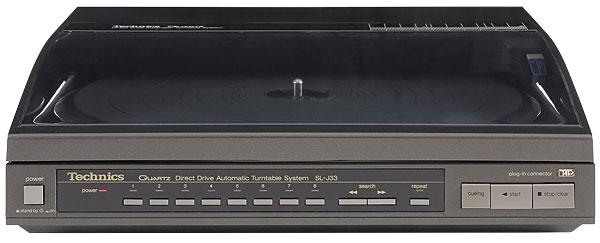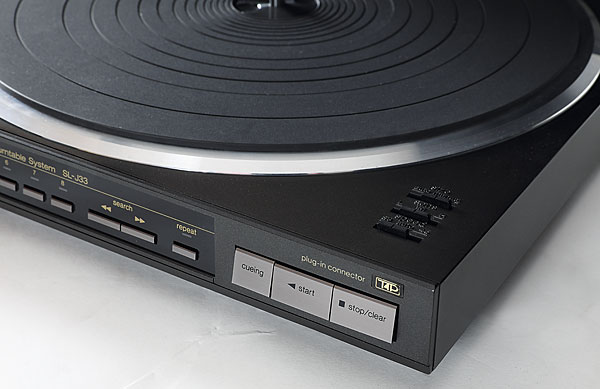Technics SL-J33 turntable

 A mid '80s deck designed to boost vinyl replay at a time when the convenience of CD was making all the news. Did it succeed, and how does it compare today?
A mid '80s deck designed to boost vinyl replay at a time when the convenience of CD was making all the news. Did it succeed, and how does it compare today?
The products we usually seek to feature in our Vintage Review pages are those that were among the first to introduce a new format, function, level of performance or design theme. However, this month our subject is the Technics SL-J33 turntable of 1986, one of the last in a series that had a footprint the size of an LP sleeve, which began with the SL-10 [HFN Apr '19].
Staying true to the original concept, the SL-J33 employed a linear-tracking arm mounted in the player's lid and a quartz-locked direct-drive motor, despite the fact that since the launch of the SL-10 in 1979 many cheaper models had appeared that lacked both these features.

Right On Track
Still, to a public that was by then highly aware of CD and all the user-convenience it could bring, even this configuration could have been viewed as a tad lacklustre in its appeal. So, in order to keep the business of playing records feeling both modern and relevant, a really effective track finding and programming system was also incorporated into the SL-J33.
Of course, turntables able to identify the position of tracks on a record and access them directly were nothing new in 1986. The ADC Accutrac 4000 [HFN Mar '13] could do it, and by then this was a design that was ten years old. But better microprocessors and the use of linear tracking made the facility easier to include in the SL-J33. Indeed, during 1980 Technics introduced the SL-15, which was a modified SL-10 with track-sensing systems added in lieu of the MC cartridge and integral head amplifier. Although it never really captured the imagination of British audiophiles of the time, the SL-15 did demonstrate that a track-sensing system could be fitted to a performance-orientated turntable without degrading its sound. The SL-J33 was directly descended from the SL-15, but re-engineered to suit the market conditions of the late 1980s.

Arm Mechanics
Where the SL-15 had employed die-cast alloy in its construction the SL-J33 used mostly moulded plastic. This gave it a cheaper, less substantial, appearance but what was inside was still of high quality. The mechanics of the arm and the manner in which it was integrated with the lid hinge had changed little over the years. SL-10 designer Yosumi Toshikazu's solutions to the original problems inherent in this layout clearly could not be improved upon.
Matsushita, the parent company of Technics, had spent a lot of time and money developing direct-drive motors for video applications and the benefits of this spilled over into the design of the SL-J33. A quartz-locked servo with both frequency and phase-control loops to ensure absolute speed stability and accuracy was employed, along with the established Technics idea of assembling the rotating part of the motor as an integral part of the platter.
As before, the platter was effectively damped by a thick rubber mat, although there was no mat bonded to its underside as was the case with the SL-10. To compensate for the rigidity lost in the upper plinth structure the base of the SL-J33 was cast in TNRC (Technics Non Resonant Compound), a proprietary material used in many of the top Technics decks of the period. A basic EPC-P30 MM cartridge was supplied, but thanks to the T4P mounting system this was easily upgraded if the owner so desired.

In common with virtually every turntable that includes track-searching facilities, the SL-J33 employs an optical sensor mounted next to the arm which can detect the more widely spaced grooves between the tracks of a record. Infra-red light is shone onto the record surface at an oblique angle and then received by a closely mounted photocell. As the arm scans the record the microprocessor notes the position of every pulse of correctly reflected light, measured by counting the number of revolutions of the motor that drives the linear-tracking system.
Rule Of Thumb
As with all such schemes, a method for adjusting the exact relationship between the stylus tip and the sensor is necessary so that the music always starts 'on cue' when a selection is made. This is frequently a mechanical arrangement that shifts the sensor in respect to cartridge. However, in the SL-J33 a different method is used. The sensor and cartridge are mounted next to each other at a fixed distance and the internal software is coded to always set the stylus down slightly early, ie, a few grooves to the right of the selected track's start point.
As the previous track plays out, the output to the amplifier is muted by a relay for a short, but adjustable, period. Using a thumb wheel that is located at the rear of the plinth, the user simply sets the length of this period so that the end of the previous track is effectively silenced and the chosen one is not cropped.

The key to how the SL-J33's automation operates is an innocuous little slide switch next to the platter labelled 'size'. Setting this to 'auto' is what makes the magic happen. Once the lid is shut, the arm travels to the centre of the platter and back at a brisk pace. As this takes place, the sensor determines whether there is a record present and, if this is the case, it registers its size, how many tracks it has and where they are located.
As tracks are found, a row of up to eight red LEDs light up. These are the available selections, and it works just like a CD player reading a disc's table of contents (TOC). If a 12in record is detected the speed is automatically set to 33.33rpm while if a 7in one is found then 45rpm is chosen.
Reverse Play
There is a manual override for this automation, which can be used when playing discs such as EPs and 12in singles. Also, if no record is found, all the controls are locked until the lid is opened again. Tracks can be set to play in any order just by pressing the keys underneath the relevant red LED and you could play everything on one side of an LP in reverse order, should the mood take you. Alternatively, just press 'play' and the deck will play the whole side. Setting the size switch to 'manual' disables all these functions, but now use must be made of the speed switch, the arm traverse keys and the cueing button.


















































